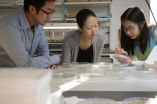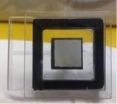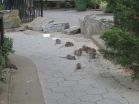(Press-News.org) DENVER (Oct. 14, 2014) – America's streets are designed and evaluated with a an inherent bias toward the needs of motor vehicles, ignoring those of bicyclists, pedestrians, and public transit users, according to a new study co-authored by Wesley Marshall of the University of Colorado Denver.
"The most common way to measure transportation performance is with the level-of-service standard," said Marshall, PhD, PE, assistant professor of civil engineering at the CU Denver College of Engineering and Applied Science, the top public research university in Denver. "But that measure only tells us about the convenience of driving a car."
Marshall co-wrote the study with Eric Dumbaugh, PhD, associate professor at Florida Atlantic University and director of Transportation and Livability for the Center for Urban and Environmental Solutions and Jeffrey Tumlin, owner and director of strategy at Nelson\Nygaard Consulting Associates in San Francisco.
According to Dumbaugh, many people assume roads are designed with all users in mind when in fact they are dedicated almost entirely to the needs of motor vehicles.
"Transit, bikes, and pedestrians are seen as worthwhile only by how much they reduce delays or increase speeds for motor vehicles," he said. "Regardless of how efficient they may be in moving people."
The study said that the values and interests of a specific means of travel – the personal automobile – dominate the thinking of those who design the nation's transportation systems. And those values may not be the same as those of the communities they serve.
For example, level-of-service or LOS measures focus on traffic congestion and time spent at intersections. They measure the movement of vehicles rather than people so a single passenger car counts as much as 50 people on a bus.
"Cities like Denver have policies promising to 'move people, not cars,' but the typical traffic engineer continues to rely upon performance measures like LOS that favor automobiles," Marshall said. "In most cases, these engineers are well-intentioned and simply following what has long been considered good practice; however, we all need to be more aware of the biases inherent to our typical metrics and harmful implications of continuing to use them."
The study said these standards are based on faulty assumptions including the notion that traffic delays hurt the economy and congestion can be avoided by investment in infrastructure.
In fact, a previous study by Dumbaugh revealed that as per capita traffic delay went up, so did per capita Gross Domestic Product. Every 10 percent increase in traffic delay per person was associated with a 3.4 percent increase in per capita GDP.
That's because traffic congestion is usually a byproduct of a vibrant, economically productive city, the study said.
Marshall said that "actively trying to reduce congestion rarely works." While widening roads offers a temporary fix, it creates additional traffic that simply fills the new capacity.
"The good news is that when cities become more congested, people adapt," Marshall said. "They change travel modes, travel shorter distances, and eventually find places to live that are more location efficient."
The researchers concluded by urging planners and policy makers to move away from faulty measures that result in transportation systems focused entirely on automobiles at the expense of more efficient, healthier modes of travel.
INFORMATION:
The study was published recently in the Institute of Transportation Engineers Journal.
The University of Colorado Denver College of Engineering and Applied Science offers a range of comprehensive engineering programs that focus on real-world problems and solutions designed to meet current and future industry needs while fostering an environment for creative problem solving. Undergraduate programs are accredited by the Engineering Accreditation Commission (EAC). Students and faculty build working relationships with area industries and organizations through hands-on research and learning experiences.
Study exposes bias in transportation system design
Roads built for automobiles -- bikes, public transit, pedestrians ignored
2014-10-14
ELSE PRESS RELEASES FROM THIS DATE:
Defective gene renders diarrhoea vaccine ineffective
2014-10-14
Every year rotavirus causes half a million diarrhoea-related deaths amongst children in developing countries. Existing vaccines provide poor protection. The reason could be a widespread genetic resistance amongst children, according to virologists at Linköping University.
Acute diarrhoeal illnesses cause nearly one-fifth of all child deaths in developing countries. The most common cause is rotavirus. Improved sanitation and hygiene have had a limited effect on the spread of the illness. Today, vaccination is considered the most important method for reducing mortality. ...
Common gene variants linked to delayed healing of bone fractures
2014-10-14
Slow-healing or non-healing bone fractures in otherwise healthy people may be caused by gene variants that are common in the population, according to Penn State College of Medicine researchers.
"We found associations between certain gene polymorphisms and delayed fracture healing in a sample of patients," said J. Spence Reid, professor of orthopaedics and rehabilitation. "Our study was preliminary but it demonstrated the feasibility of a larger one, which we're now working to set up."
The identification of gene variants that delay fracture healing could lead to screening ...
Precise control over genes results from game-changing research
2014-10-14
The application of a new, precise way to turn genes on and off within cells, described online October 9, 2014 in two articles in the journal Cell, is likely to lead to a better understanding of diseases and possibly to new therapies, according to UC San Francisco scientists.
The key to the advance is a new invention, called the SunTag, a series of molecular hooks for hanging multiple copies of biologically active molecules onto a single protein scaffold used to target genes or other molecules. Compared to molecules assembled without these hooks, those incorporating the ...
Discovery of cellular snooze button advances cancer and biofuel research
2014-10-14
EAST LANSING, Mich. – The discovery of a cellular snooze button has allowed a team of Michigan State University scientists to potentially improve biofuel production and offer insight on the early stages of cancer.
The discovery that the protein CHT7 is a likely repressor of cellular quiescence, or resting state, is published in the current issue of the Proceedings of the National Academy of Sciences. This cellular switch, which influences algae's growth and oil production, also wields control of cellular growth – and tumor growth – in humans.
Christoph ...
Sustained feedback to doctors may help maintain appropriate antibiotic usage in children
2014-10-14
A program that provides guidance to primary care physicians about appropriately prescribing antibiotics for children is effective, but its improvements wear off after regular auditing and feedback are discontinued.
"Our findings suggest that interventions with outpatient healthcare providers should include continued feedback to clinicians to remain effective," said study leader Jeffrey S. Gerber, M.D., Ph.D., an infectious diseases specialist at The Children's Hospital of Philadelphia (CHOP).
Gerber and colleagues from CHOP published their research online Oct. 10 in ...
Earliest-known lamprey larva fossils unearthed in Inner Mongolia
2014-10-14
LAWRENCE — Few people devote time to pondering the ancient origins of the eel-like lamprey, yet the evolutionary saga of the bloodsucker holds essential clues to the biological roots of humanity.
Today, the Proceedings of the National Academy of Sciences published a description of fossilized lamprey larvae that date back to the Lower Cretaceous — at least 65 million years ago.
They're the oldest identified fossils displaying the creature in stages of pre-metamorphosis and metamorphosis.
"Among animals with backbones, everything, including us, evolved from ...
Stress may be harder on women's hearts than men's
2014-10-14
DURHAM, N.C. -- Researchers have known for decades that stress contributes to heart disease. But a new analysis by researchers at Duke Medicine shows mental stress may tax women's hearts more than men's.
The research appears online Oct. 13, 2014, in the Journal of the American College of Cardiology.
"Normally when under stress, we fight back or run away. In order to do that, we need to pump more blood to the body," said Wei Jiang, M.D., the study's senior author and professor of medicine, psychiatry and behavioral sciences at the Duke University School of Medicine. ...
Beyond LEDs: Brighter, new energy-saving flat panel lights based on carbon nanotubes
2014-10-14
Washington D.C., October 14, 2014 -- Even as the 2014 Nobel Prize in Physics has enshrined light emitting diodes (LEDs) as the single most significant and disruptive energy-efficient lighting solution of today, scientists around the world continue unabated to search for the even-better-bulbs of tomorrow.
Enter carbon electronics.
Electronics based on carbon, especially carbon nanotubes (CNTs), are emerging as successors to silicon for making semiconductor materials. And they may enable a new generation of brighter, low-power, low-cost lighting devices that could challenge ...
Rats of New York and the diseases they carry
2014-10-14
In the first study to look at would-be diseases carried by New York City rats, scientists at the Center for Infection and Immunity at Columbia University's Mailman School of Public Health identified bacterial pathogens, including E. coli, Salmonella, and C. difficile, that cause mild to life-threatening gastroenteritis in people; Seoul hantavirus, which causes Ebola-like hemorrhagic fever and kidney failure in humans; and the closest relative to human hepatitis C. Results appear in the journal mBio.
The researchers trapped 133 Norway rats at 5 sites in New York City, ...
'Grapes of Wrath': Stomping out grape disease one vineyard at a time
2014-10-14
Cracking the genetic code of a common disease affecting grape production could improve vineyard management and help protect the multibillion-dollar industry that includes raisins, juice, jam/jelly, fresh grapes, grape-seed extract and oil, vinegar and wine.
A Rochester Institute of Technology scientist and an RIT alumnus are close to completing the genetic blueprint, or microbiome, of grape crown gall tumor disease—the bane of vineyards worldwide. Their study focuses on 16 grape varieties, including Cabernet Sauvignon and Riesling, from vineyards in the New York ...
LAST 30 PRESS RELEASES:
How talking slows eye movements behind the wheel
The Ceramic Society of Japan’s Oxoate Ceramics Research Association launches new international book project
Heart-brain connection: international study reveals the role of the vagus nerve in keeping the heart young
Researchers identify Rb1 as a predictive biomarker for a new therapeutic strategy in some breast cancers
Survey reveals ethical gaps slowing AI adoption in pediatric surgery
Stimulant ADHD medications work differently than thought
AI overestimates how smart people are, according to HSE economists
HSE researchers create genome-wide map of quadruplexes
Scientists boost cell "powerhouses" to burn more calories
Automatic label checking: The missing step in making reliable medical AI
Low daily alcohol intake linked to 50% heightened mouth cancer risk in India
American Meteorological Society announces Rick Spinrad as 2026 President-Elect
Biomass-based carbon capture spotlighted in newly released global climate webinar recording
Illuminating invisible nano pollutants: advanced bioimaging tracks the full journey of emerging nanoscale contaminants in living systems
How does age affect recovery from spinal cord injury?
Novel AI tool offers prognosis for patients with head and neck cancer
Fathers’ microplastic exposure tied to their children’s metabolic problems
Research validates laboratory model for studying high-grade serous ovarian cancer
SIR 2026 delivers transformative breakthroughs in minimally invasive medicine to improve patient care
Stem Cell Reports most downloaded papers of 2025 highlight the breadth and impact of stem cell research
Oxford-led study estimates NHS spends around 3% of its primary and secondary care budget on the health impacts of heat and cold in England
A researcher’s long quest leads to a smart composite breakthrough
Urban wild bees act as “microbial sensors” of city health.
New study finds where you live affects recovery after a hip fracture
Forecasting the impact of fully automated vehicle adoption on US road traffic injuries
Alcohol-related hospitalizations from 2016 to 2022
Semaglutide and hospitalizations in patients with obesity and established cardiovascular disease
Researchers ‘listen in’ to embryo-mother interactions during implantation using a culture system replicating the womb lining
How changing your diet could help save the world
How to make AI truly scalable and reliable for real-time traffic assignment?
[Press-News.org] Study exposes bias in transportation system designRoads built for automobiles -- bikes, public transit, pedestrians ignored




